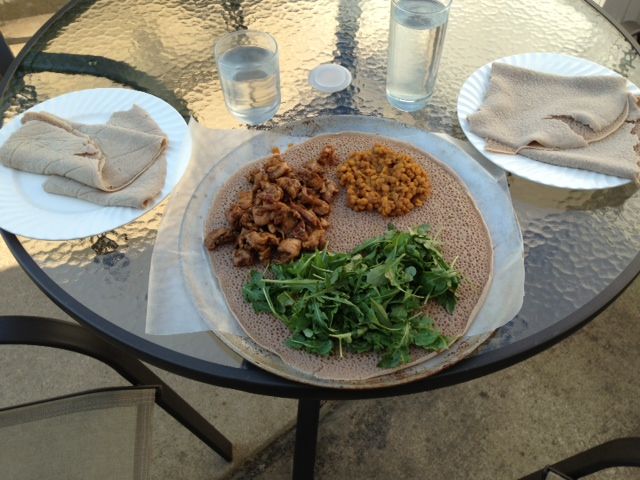In the early days of my relationship with Mike, I was an unadventurous (he would say bland) eater. Half the time, my lunches on campus consisted of chicken strips with honey mustard (although in my defense, I did eat a lot of spinach-tomato-feta pizza, which I think is a few steps above chicken strips on the culinary adventurousness scale). The first time Mike took me to a Thai restaurant, I ordered cream cheese wontons. The first time I spent the holidays with his family in Boulder, we went to a nice Indian restaurant on Christmas Eve. Instead of trying anything even a tiny bit different from what I was used to, I ate a plateful of Chinese-American style orange chicken with white rice (there was much eye-rolling from Mike). I ordered everything mild and claimed that I didn't like garlic. Mike's all-time favorite cuisine is Ethiopian, and I was secretly grateful that our northern Minnesota college town didn't have an Ethiopian restaurant he could force me to try.
Unfortunately for me, my luck changed on a visit to his parents. Mike's parents are just as enthusiastic about Ethiopian food as he is, and they made clear that a visit to the greater Milwaukee area would not be complete without a meal at the Ethiopian Cottage. I approached dinner with trepidation. Mike had explained that Ethiopian food is served family-style, on a large platter of injera, a spongy, tangy flatbread, and instead of utensils, you use pieces of injera to pick up the food. The whole thing sounded like a mess to me, and I was convinced that I wouldn't like the taste of it either.
I don't remember what I ordered--I was still eating meat at the time, so it probably was one of the chicken dishes. In spite of all of my negative preconceptions, it was love at first bite. The texture of injera, spongy and fluffy, combined with its tangy flavor (the closest comparison I can come up with is a giant sourdough pancake) perfectly complemented the richly spiced stewed meat. As I started eating a vegetarian-based diet, I was delighted with the plethora of lentil, pea, chickpea, and other vegetable dishes that Ethiopian restaurants typically offer. By the time we moved to the Twin Cities, I was just as excited as Mike to check out the Ethiopian dining options.
Our favorite Ethiopian restaurant is the Blue Nile, but we discovered that the Holy Land Grocery and Butcher Shop at the Midtown Global Market sells injera and we also occasionally make Ethiopian food at home. We spent our New Year's Eve cooking up an Ethiopian-style feast of fried beef and yellow split pea stews, with help from Exotic Ethiopian Cooking by D.J. Mesfin and a recipe I've adapted below from Ras Kassa's Ethiopian Restaurant in Boulder, Colorado.
Adapted from Ras Kassa's Ethiopian Restaurant, Boulder, Colorado
Serves two as a main dish
Ingredients:
- 1 tablespoon olive oil
- 1/2 cup chopped onion
- 1 clove garlic, minced
- 1/2 teaspoon grated fresh ginger
- 1 1/2 tablespoons berbere spice blend (I've found it at East African grocery stores and Whole Foods Market, or you can make your own)
- 2 1/2 cups water
- 1 cup yellow split peas
- injera, for serving
Heat olive oil in medium saucepan over medium heat. Add onion, garlic, and ginger and cook until onion is translucent and garlic is lightly browned, about 5 minutes. Add berbere, water, and peas and bring to boil. Cover and reduce heat to low. Simmer until peas are tender and have formed a thick stew, about 50 minutes.
Serve on injera.


